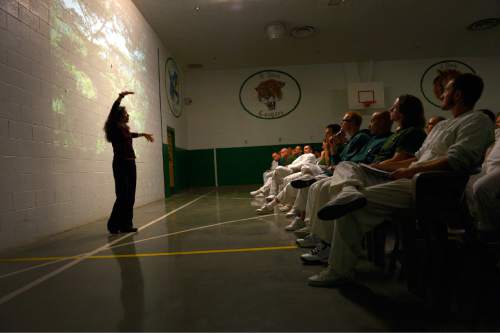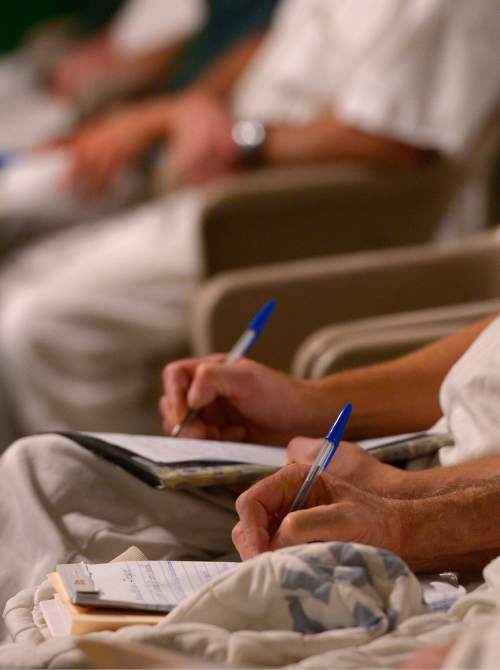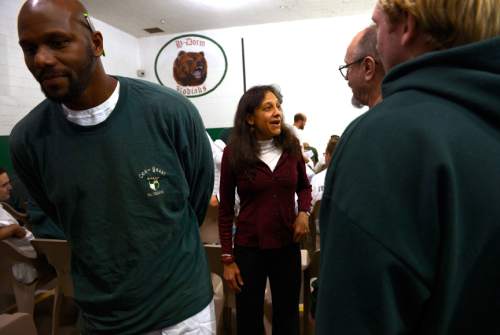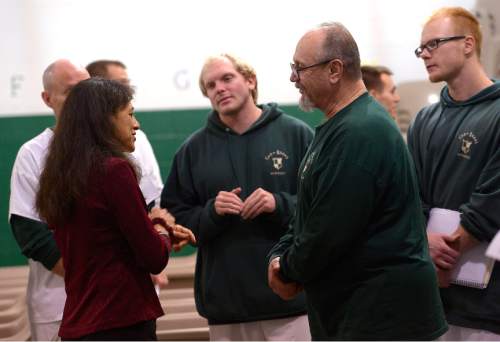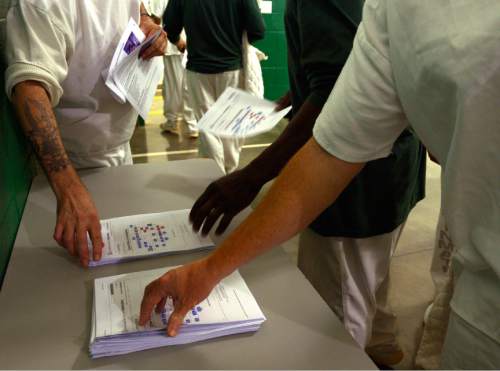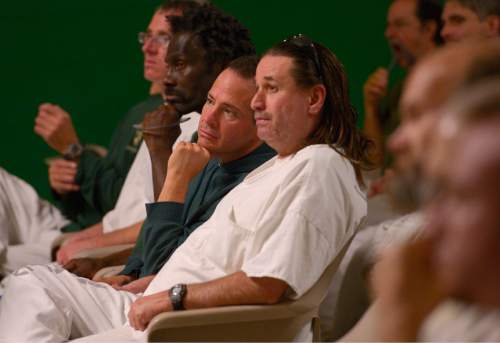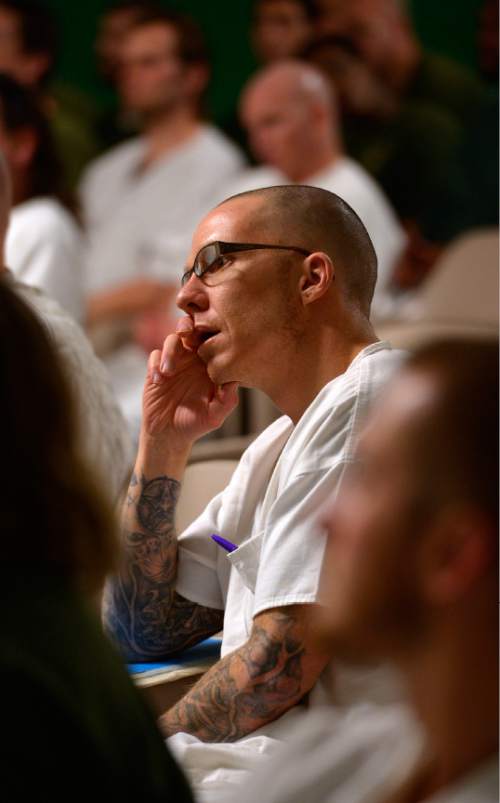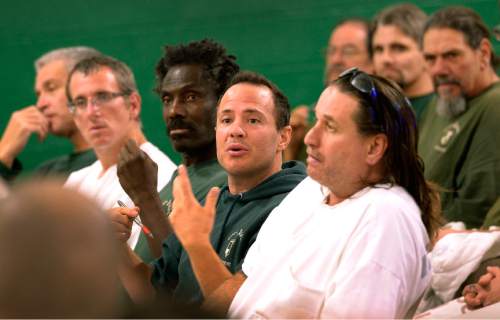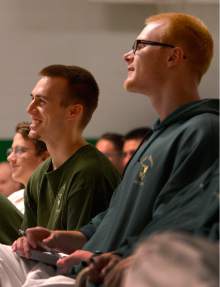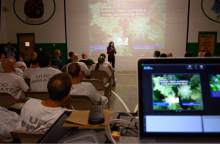This is an archived article that was published on sltrib.com in 2014, and information in the article may be outdated. It is provided only for personal research purposes and may not be reprinted.
Draper • Before he started sluffing school, smoking weed and getting into meth, Jesse David liked learning why plants turn to face the sun.
The 28-year-old Clearfield native is one of about 75 state prison inmates in a drug and alcohol treatment program who put aside dumbbells and free weights Tuesday evening to talk about trees and moss.
The arboriculture lesson in the Utah State Prison's cinder-block gym was the first of a new monthly lecture series designed to draw inmates into conservation as a way to cut down on repeat offenses.
"It rekindled a little bit of a flame in me," said David. "I want to do that — just get out in nature and be a part of it."
A University of Utah biology professor hopes to make that happen. Nalini Nadkarni wants the group to help her study how desert brush and weather affect sage grouse populations.
"This lecture series is about lighting those sparks," she said after the talk.
Nadkarni has had success with a similar program in Washington state, where she and other biologists in recent years enlisted inmates to study Oregon spotted frogs and moss varieties.
On Tuesday night, the men in white corrections gear and green sweatshirts watched National Geographic footage of Nadkarni scaling Costa Rican rain forest tree canopies.
Some in the group, which spanned decades, nodded off. Others scribbled in notebooks and murmured.
Nadkarni reminded them that pines keep their needles year-round, showed photos of neon-flecked eucalyptus bark and reviewed vast underground root systems.
Some asked how big of a role trees play in maintaining Utah's watersheds. Others wondered aloud if they could get a conservation job after getting out of prison.
"Can we participate in all these different scientific experiments if we're felons?" asked 34-year-old Gregory Gafford, convicted of aggravated assault.
It depends on the research leader, Nadkarni said. When she considers candidates for her own teams, she said, her first question is, "Does this person seem like a hardworking, curious person?"
Nadkarni likens the nation's overtaxed prison system — facing growing populations and high rates of recidivism — to her research topic. Trees have deep roots and appear static, she says, but their twigs can bend and adapt.
"I always think that education is the answer," she said.
Besides giving lectures, Nadkarni meets with inmates in isolation working to bring murals into exercise yards. It's a small step, she says, toward reducing violence in those units.
Nationally, similar programs are underway: Two are still ongoing in Washington and others have started in Ohio and California.
Nadkarni came to the U. three years ago from Evergreen State College in Olympia, Wash., where she taught for two decades. Now, she leads the U.'s Center for Science and Mathematics Education.
In Utah, the new series is the state's second science program geared at incarcerated people. At the Salt Lake County Jail, inmates trek to the Great Salt Lake to study invasive grasses and the diminishing species of tiny fish known as the least chub.
The Draper prison already offers courses through school districts and technology colleges, but this is the first chance for those within its walls to absorb university-level science.
"I hope it can keep growing," said Corrections spokeswoman Brooke Adams.
Nadkarni says it took three years to bring the Tuesday lecture to fruition, so it could be a while before researchers win final approval for fieldwork from any of the state's 7,000 incarcerated men and women. But she is confident that it will happen eventually.
In Washington, the prison program is growing, said Kelli Bush, program manager for the Sustainability in Prisons Project.
Lecturers in two of the state's facilities now choose topics based on inmates' requests. Those topics range from beekeeping to recycling and environmental justice. A part-time employee coordinates the talks, which have drawn overflow crowds now limited to the first 60 inmates to show up.
"They want more than we can provide," Bush said in a telephone interview. "We've had to cap our attendance because the room simply can't hold all the people who want to attend."
Many in the audience say they are excited to go back to school after leaving prison, Bush said. That's important in a state where 97 percent of inmates will rejoin the larger population after serving their sentences. But it's still early to tell whether the classes have lowered recidivism in Washington.
In Utah, more than half of ex-cons bounce back to prison within three years, according to a 2011 national Pew Center study. But it's an improvement from about 10 years earlier, when two-thirds of former inmates returned to prison — the highest rate nationwide.
Nadkarni, Bush said, "talks about education leading people out of their current circumstances. And that's what we think this has the ability to do."
In Utah, Jesse David is serving a nearly two-year sentence for stealing credit cards from the drive-through window at his old burger-chain job. He hadn't thought much about trees since junior high, he said, but after the talk, David said he was considering pursuing a bachelor's degree in ecology.
Gafford, who is from Chicago, agreed. He used to play around with moss when he went fishing as a kid and said he wants to learn more about it. Both men said they plan to attend coming science and math lectures from a roster of U. faculty and graduate students.
"It got my creative juices going, trying to decide where to take my life at this point," Gafford said. "You'll see me here every time."
@anniebknox


